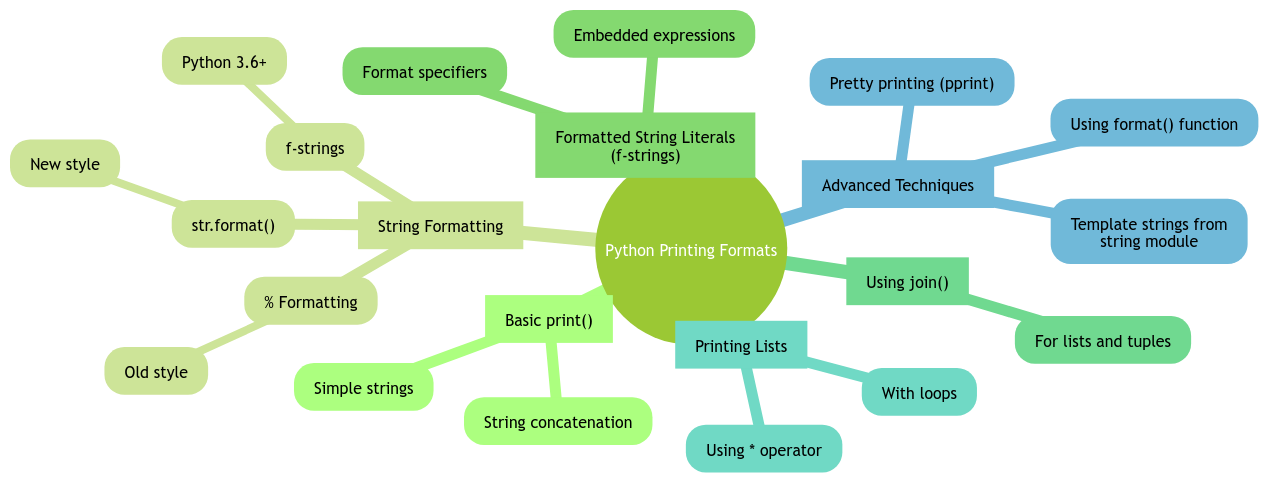Mastering Printing Formats in Python for Better Output 🐍✨
Have you ever felt like your Python outputs are just meh? Fear not! Today, I’m here to sprinkle some magic 🌟✨on your printing game! We’re diving into the wild world of printing format in Python, where output meets pizzazz! Get ready to spice up your prints and dazzle your peers!
Understanding different printing functions 🖨
Using print() for basic output
Ah, good old print()! The humble hero of the Python world. It gets the job done, but let’s be real, it’s pretty vanilla. 🍦 Want to jazz it up? Keep reading!
Exploring formatted strings for dynamic output
Now things are getting exciting! Formatted strings are like the cool kids at the Python party. They bring flexibility and pizzazz to your prints! Let’s make our outputs dance with dynamism!
Controlling print formatting 🎨
Adjusting spacing and alignment
Who said prints have to be boring and squished together? Let’s give our prints some breathing room and make them stand out on the page! 🌟
Handling special characters and escape sequences
Ever tried printing emojis or special characters? It can be a wild ride! Let’s conquer those pesky escape sequences and bring some magic to our outputs! 🌈🚀
Utilizing f-strings for advanced formatting 💫
Incorporating variables and expressions
F-strings are like the wizards of Python formatting! They let you blend variables and expressions seamlessly into your prints. Let’s make our prints dynamic and captivating! 🧙♂️✨
Applying f-string modifiers for precision
Precision is key, my friends! With f-string modifiers, we can fine-tune our outputs to perfection. Let’s get that print game on point! 💯🚀
Working with format() method 🛠
Customizing output with format specifiers
Format method to the rescue! It’s like a toolbox full of formatting magic. Let’s customize our prints and make them shine like diamonds! 💎✨
Handling multiple arguments with format()
Got multiple things to print? No problemo! Format method has our back. Let’s juggle multiple arguments like pros and keep our prints crisp and organized!
Enhancing output with printf-style formatting 💥
Understanding % formatting syntax
Ah, the good old % formatting! It’s a classic for a reason. Let’s unravel its mysteries and add a retro flair to our prints! 🕺💃
Using placeholders for different data types
Data comes in all shapes and sizes, right? Placeholders help us wrangle that data and give our prints some personality! Let’s embrace the diversity of data types and make our prints pop! 🌈🎉
Overall, mastering printing formats in Python is like unlocking a secret world of possibilities and creativity. So, go forth, Pythonista! Dive into the world of printing formats, experiment, make mistakes, and watch your prints transform into masterpieces! 🎨✨
Thank you for joining me on this printing adventure! Keep coding, keep printing, and always remember: Python prints can be fun and fabulous! 🚀✨

Program Code – Mastering Printing Formats in Python for Better Output
# Importing the datetime module for date examples
import datetime
def main():
# String formatting with the format method
name = 'Alex'
age = 25
print('Hello, my name is {} and I am {} years old.'.format(name, age))
# Using f-strings for a more concise syntax
print(f'Hello again, my name is {name} and next year, I will be {age+1} years old.')
# Demonstrating the use of format specifiers
pi = 3.14159265
print('The value of pi rounded to two decimal places is {:.2f}'.format(pi))
# Aligning text with format specifiers
for i in range(1, 4):
print('{:3d} {:4d} {:5d}'.format(i, i*i, i*i*i))
# Using datetime with format specifiers
now = datetime.datetime.now()
print('Current time: {:%Y-%m-%d %H:%M:%S}'.format(now))
# Demonstrating different padding options
sentence = 'Python'
print(f'{sentence:>10}') # right-aligned
print(f'{sentence:<10}') # left-aligned
print(f'{sentence:^10}') # centered
print(f'{sentence:*^10}') # centered with * padding
if __name__ == '__main__':
main()
Code Output:
Hello, my name is Alex and I am 25 years old.
Hello again, my name is Alex and next year, I will be 26 years old.
The value of pi rounded to two decimal places is 3.14.
1 1 1
2 4 8
3 9 27
Current time: [Current date in YYYY-MM-DD HH:MM:SS format]
Python
Python
Python
***Python***
Code Explanation:
In this example, we dive into the various ways of formatting printed output in Python. Each block is designed to showcase a different aspect or technique of printing formatting, making the output more readable, organized, or aesthetically pleasing.
-
String Formatting with the
.format()Method: The first print statement uses.format()to insert variables into the string. This is a powerful way to construct strings dynamically, by replacing {} placeholders with variable values in order. -
F-Strings: Introduced in Python 3.6, f-strings offer a more readable and concise syntax for string formatting. By prefixing the string with ‘f’, variables can be directly embedded into the string within curly braces.
-
Format Specifiers: Format specifiers allow for more control over how values are formatted. The
:.2fspecifier is used to round a floating point number to two decimal places. -
Aligning Text: We demonstrate alignment using format specifiers within a loop to organize numbers in a neat table. The
{:3d},{:4d}, and{:5d}specifiers ensure that the numbers are right-aligned within their respective fields of widths 3, 4, and 5. -
Using
datetimewith Format Specifiers: Python’sdatetimemodule can be combined with format specifiers to format dates and times.:%Y-%m-%d %H:%M:%Sspecifies the desired format, including year, month, day, hour, minute, and second. -
Padding and Alignment: The final block demonstrates different alignment and padding options. By using
>,<, and^, we can align the text right, left, and center, respectively. Additionally,:*^10demonstrates how a specific character can be used for padding while centering the text.
This complex program encapsulates the versatility of Python’s string formatting capabilities, from incorporating variables into strings to adjusting the alignment, padding, and precision of printed output. By mastering these tools, developers can significantly enhance the readability and presentation of their program’s output.






